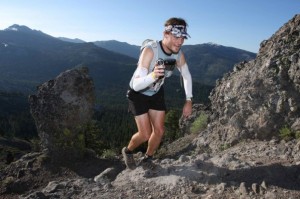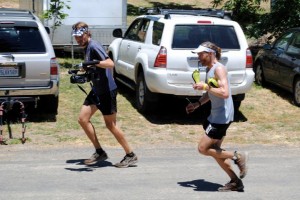Among runners like me who follow the sport of trail running and its constellation of ultrarunning stars, one soon-to-be-released film is generating buzz, in spite of its low profile, as the must-see of the season: Unbreakable: The Western States 100. The documentary by Journeyfilm captures the extraordinary drama and physical effort of the 2010 Western States 100-Mile Endurance Run.
The film isn’t quite done yet. Filmmaker JB Benna, the 32-year-old owner of Journeyfilm and a bad-ass ultrarunner, is jamming this week to finish the final edit. Special screenings take place November 25 – December 18, mostly hosted by runners—and you can sign up to host a screening, too, or find out where one is happening, through the website. The film’s official release by DVD is December 20.
I caught JB on the phone the other day as he was driving around Reno/Tahoe, where he now lives with his wife and 1-year-old daughter and holds down a full-time job managing video production for a major marketing company. He took time out to talk about the making of Unbreakable, which profiles four leading contenders in the race: Kilian Jornet, Hal Koerner, Anton (Tony) Krupicka and Geoff Roes. Check out the trailer:
“It all came together kind of last minute,” he said of making Unbreakable. “I already knew Hal was in [the 2010 Western States race], but just a few weeks before, I learned that Tony and Geoff were going to be in the race as well. I knew that Geoff was completely undefeated at the 100-mile distance, I knew Tony had never lost an ultramarathon at all—every race he’d entered, he’d won—and I knew Hal had won the last two versions of Western States. So on that alone, I knew it was going to be a good race and it would be interesting to see what happens to these guys who are undefeated—who’s gonna break, who’s gonna succeed?”
And what about Kilian, the wild card who ran Western States for the first time in 2010—Kilian, the incredible 24-year-old Spaniard who won this year’s Western States and Ultra Trail du Mont Blanc, the star of Salomon Running’s video series Kilian’s Quest?
“I didn’t even know Kilian was in, initially,” JB said. “It was after I started to make the film that I found out Kilian was going to be there as well, and he was undefeated in Europe. It was four of the sport’s superstars all going to the sport’s biggest event. I didn’t really know what it would turn into and didn’t expect the day to unfold the way it did, but it was a monumental day for our sport in a lot of ways. I was blown away all day by these guys and the drama unfolding. Everyone along the course was so pumped up, there was a buzz in the air.”
Though the filming of the 2010 race came together relatively last-minute, JB was well prepared because the prior year had served as a kind of dress rehearsal for him and his crew. He had, as he put it, “survived” the 2009 Western States (in a time of 28:19) while carrying a camera and capturing footage. He also filmed the race in 2006 and ’07 for another production crew, so he was quite familiar with the course—and the challenges of filming it.
“I half-heartedly attempted to make a film in 2009—at the last minute, I said, ‘I’m gonna carry a camera the whole way and get a few other guys out there to film’—and it quickly became apparent it’s a very difficult race to film logistically.”
At first, he explained, he approached the filming the way some other Western States documentaries have, focusing on a cross-section of characters on the course—some faster, some slower. “That’s how I was trying to film in 2009, but I only ended up with two shots of each person throughout the day, and I was thinking, ‘How am I going to make a film with two shots of the guy, one at Mile 30 and one of him finishing? It’s not that compelling. I realized I needed to narrow my focus on a small group of people, and I needed to be right there in the action with them.”
For the fateful weekend of June 26, 2010, he carried a 10-pound camera himself; assigned his pregnant wife, Jennifer (also an ultrarunner), to film with a handycam; and roped in his brother, who’s also a commercial director, for the crew. Plus, he enlisted about five other guys to film and crew along the course, and had some pacers run with head-mounted cams.
Ultimately, about 70 percent of the film’s footage came from JB’s camera, since he was the one chasing the frontrunners on the trail.
“I pretty much was the guy running the sections of the trail with the leaders, while everyone else on the crew was going between aid stations. I ran about 34 miles that day with the camera.”
Did he ever blow a shot? “There were a few times when my camera was on the fritz, and there was this one shot of Geoff Roes running through the meadow after Highway 49, with a golden sunset, that I’m still pretty bummed about not getting. My LCD screen had stopped working from all the dust and bouncing, and not being able to see it while running, I turned the camera off instead of on.”
Did any of the runners have a problem with him and his crew being out there? After all, it’s the biggest race of their year—maybe of their lives—and they might not want someone getting in their face with a camera or tripping them up.
No, JB said, they all were cool about him being there. “I knew all of them—except for Kilian—but even Kilian was impressed that I was running a sub-7-minute pace down the canyons with this big camera. For these runners, I was the person they saw the most throughout the day, since I was at many more places than the crews. We would all chat, and I feel that they liked venting to me. They would also ask for feedback, like, ‘How’s this person doing? How far to the next aid station?’”
Anything could have happened that day on the trail—and something unexpected did happen: JB’s good friend Hal dropped out. Was it hard for JB to see Hal suffer and DNF? “Yeah, for sure, but then again, Hal is a really experienced guy. … I don’t think he lets the bad days drag him down too long; he just accepts when it’s not his day.” Plus, JB admitted, Hal’s pre-race injury, and having him drop out, was undeniably good for the film: “He’s the one guy who broke. If they all had a super strong day, it might not have given it as much drama as if one of them didn’t falter.”
JB did most of the interviews with the runners and their families after the race. He said all were very humble and approachable, and the only roadblock he hit was getting access to Kilian. “Kilian has been bombarded with media, and in order to protect him, Salomon and his coach wouldn’t let me go film him in Spain, though I wanted to; but they are trying to provide me footage of his hometown and parents, which I’m re-editing. But the time I did spend with Kilian, he was very nice. All the other guys were super nice too. We became friends, and they let me stay with them while I was filming. It was like we were just hanging out but with a camera running constantly.”
None of the runners have seen Unbreakable yet, since the final cut is still in the works, but JB showed an early version to Hal Koerner and his Rogue Valley Runner buddies in Ashland. JB said they responded really positively to the film, including the historical elements in it. Based on their feedback, JB reworked it to feature ultrarunning pioneer Gordy Ainsleigh, the first to run Western States in 1974, more prominently.
As for JB’s own running—well, you might say his film became his de facto goal race for 2011. “I’ve only done one race this year. I was scheduled to do more, but it very quickly became apparent that having a 1-year-old, a full-time job and trying to make a feature film, something had to give, and that was my running. I’ll be getting back to running as soon as this thing is wrapped.”
He’s less certain that he’ll get back to making films when Unbreakable is complete. “It’s like asking someone if they want to run 100 miles in the middle of running 100 miles—and that only lasts for one day. After a year and a half on this film, I’m not sure I’m going to do any more feature-length films, at least for a while. I hope people enjoy Unbreakable, because I have put my all into it, and now it’s time to get back to my family and running.”



I absolutely cannot wait to see this film. I’ll have to bookmark the website for Santa.
I’m not sure what’s more impressive, the way that the leaders ran this race, or the fact that JB carried a camera for 34 miles of it.